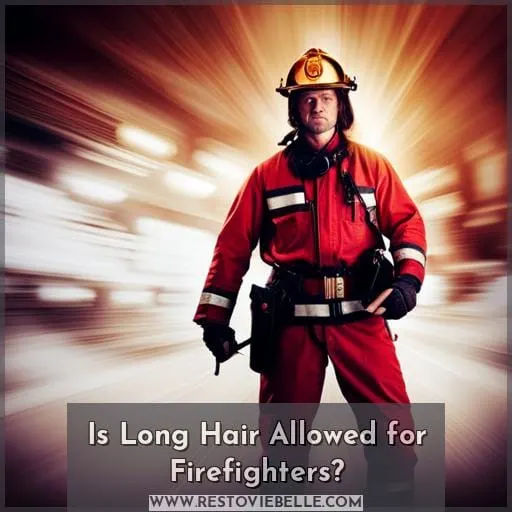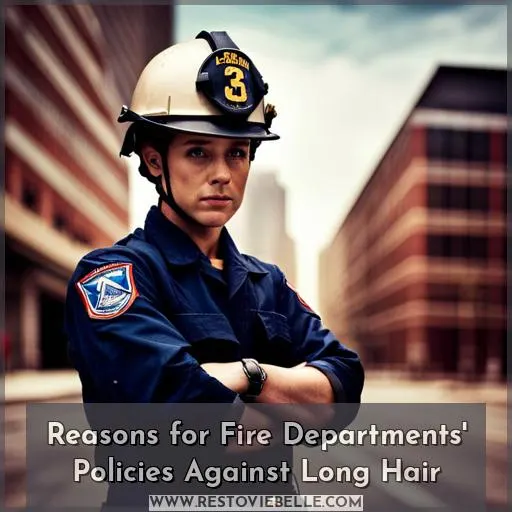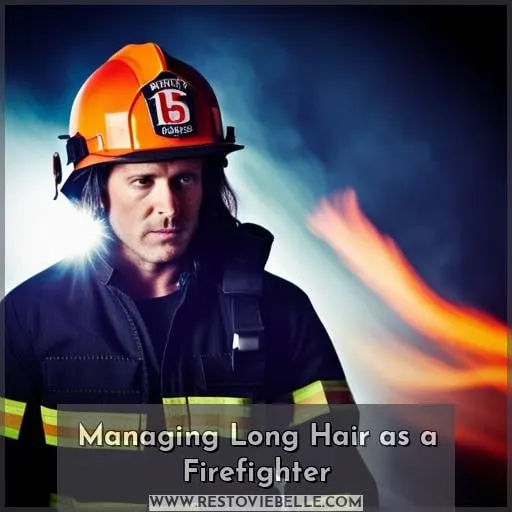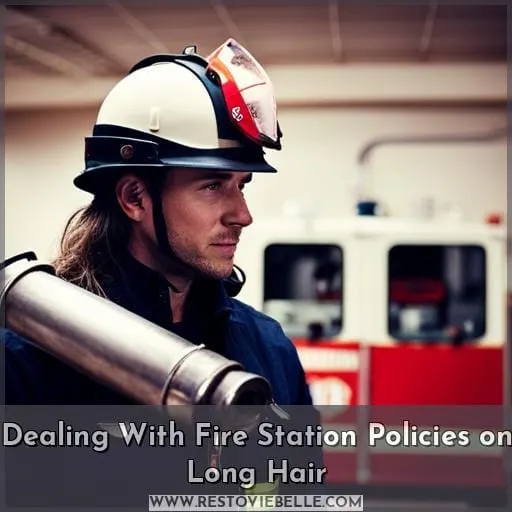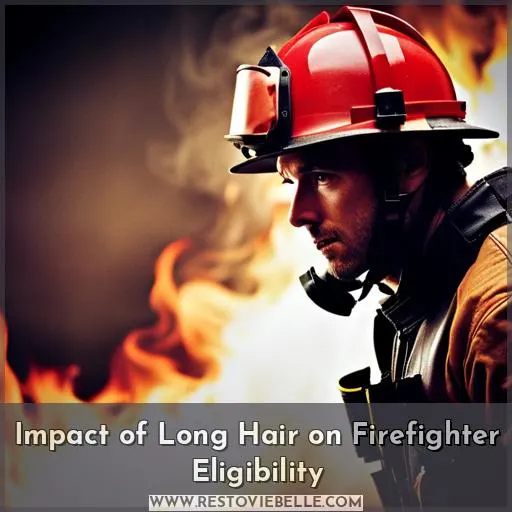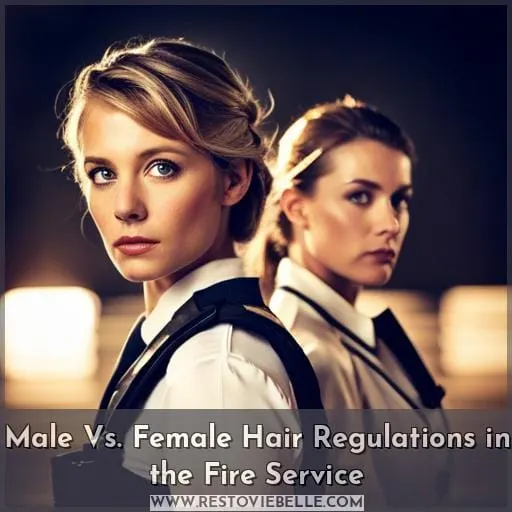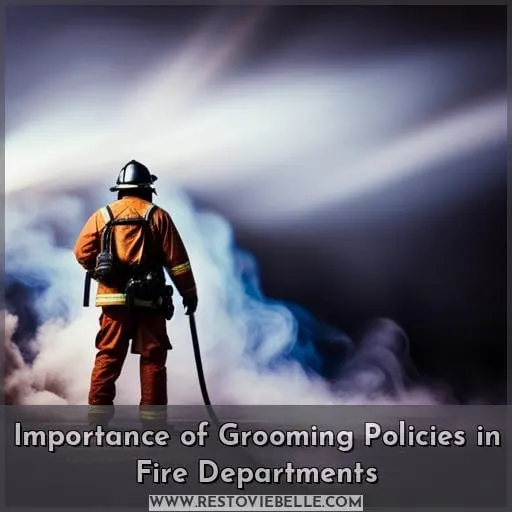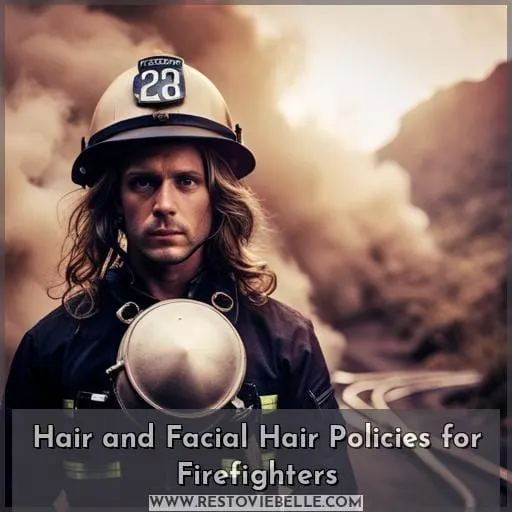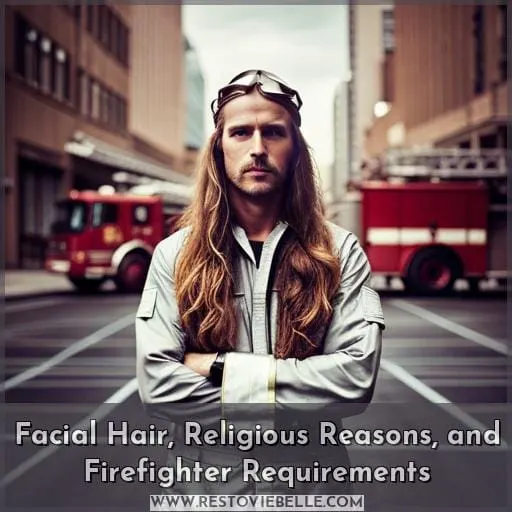This site is supported by our readers. We may earn a commission, at no cost to you, if you purchase through links.
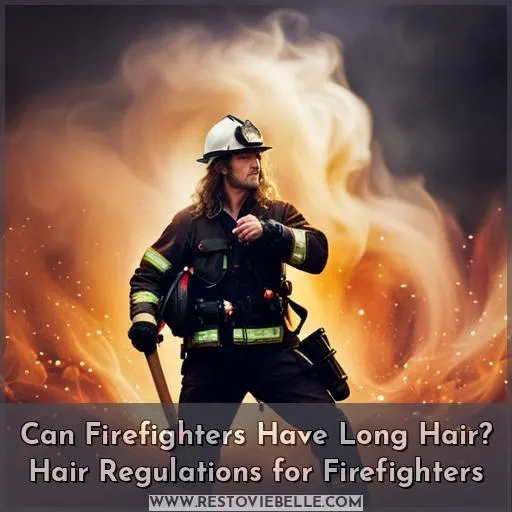 Do you want to be a firefighter, but have long hair? It’s possible, although there are some rules and regulations that must be followed. Fire departments typically have policies in place about how firefighters should groom their hair for safety reasons.
Do you want to be a firefighter, but have long hair? It’s possible, although there are some rules and regulations that must be followed. Fire departments typically have policies in place about how firefighters should groom their hair for safety reasons.
In this article, we’ll explore the details of what exactly is allowed when it comes to long hair for firefighters. This includes considerations such as equipment fitting issues and minimizing distractions during firefighting duties.
It’s important to understand the impact of long hair on eligibility requirements and any gender-specific regulations that may be in place.
Whether you already work in a fire station or are thinking of applying soon, understanding the ins-and-outs of proper grooming as a firefighter will help ensure success in your profession while keeping yourself safe at every step along the way.
Table Of Contents
- Key Takeaways
- Is Long Hair Allowed for Firefighters?
- Reasons for Fire Departments’ Policies Against Long Hair
- Managing Long Hair as a Firefighter
- Dealing With Fire Station Policies on Long Hair
- Impact of Long Hair on Firefighter Eligibility
- Male Vs. Female Hair Regulations in the Fire Service
- Importance of Grooming Policies in Fire Departments
- Hair and Facial Hair Policies for Firefighters
- Long Hair, Dreadlocks, and Dyed Hair in the Fire Service
- Facial Hair, Religious Reasons, and Firefighter Requirements
- Conclusion
Key Takeaways
- Long hair regulations for firefighters vary by department.
- Hair should not interfere with gear and should be kept professional.
- Dreadlocks may be allowed if well-groomed.
- Female firefighters may have more flexibility with hair length.
Is Long Hair Allowed for Firefighters?
You must be aware of fire department regulations regarding hairstyles, as they can vary greatly and may impact your first impression when interviewed.
Long hair is generally allowed in most fire stations – with some departments having strict policies on length. Hair must remain professional and typically should not extend past the shoulders for male firefighters or interfere with protective gear if long hair is worn by female firefighters.
Dreadlocks are acceptable if well-groomed and comfortable under protective gear; unnatural colors are usually discouraged however.
As safety is a top priority, facial piercings such as barbells, septums, or nose rings cannot be worn during operational duty due to potential interference with equipment seals during shifts and interviews – reasonable adjustments may apply for religious reasons though!
Beards can affect RPE seal efficiency so all operational staff must clean shave before attending any shift/interview but exceptions may exist according to medical requirements (such as skin conditions).
Ultimately maintaining a tidy appearance while adhering to safety guidelines will ensure that you make an excellent first impression upon arriving at the station!
Reasons for Fire Departments’ Policies Against Long Hair
In the firefighting profession, grooming policies are essential for a variety of reasons. Proper equipment and gear fitting, minimizing distractions on the job, and maintaining a professional appearance are all important considerations when it comes to having long hair as a firefighter.
Hair length regulations help ensure firefighters can perform their duties safely and efficiently while looking presentable to members of the public.
Proper Equipment and Gear Fitting
It is essential that you wear properly fitting equipment and gear to ensure safety on the job. To accomplish this, departments have hair length policies and grooming rules in place. Hair must be neatly contained during shifts. Equipment needs to fit snugly for maximum protection.
Unnatural colors are usually not allowed. Long hair should not affect firefighting duties or hinder public interaction. Facial piercings, facial hair, dreadlocks must meet certain requirements. Safety is paramount; adjustments may be considered for religious/medical reasons.
Minimizing Distractions
By maintaining a neat appearance, you can minimize potential distractions and ensure your safety while on duty. Hair maintenance and adhering to departmental protocol help maintain the focus of firefighters in high-stakes situations.
Long hair benefits, such as protection from heat and flames, must be balanced with the standards of professionalism put forth by fire departments. Facial hair regulations often restrict full beards for SCBA mask sealing but may allow for religious or medical exceptions.
Proper grooming is paramount in firefighting roles so that responses remain efficient during emergency situations.
Maintaining a Professional Appearance
Maintaining a professional appearance is essential for firefighter candidates, with regulations surrounding hair length, tattoos, and piercings, as well as general grooming habits. Fire departments prioritize safety and professionalism in their dress code expectations.
Hair policies must be adhered to. Long hair should be tied back or worn in a bun, while unnatural colors aren’t allowed. Shave requirements may also apply due to equipment fitting issues and the need for secure face seals on respiratory protection gear.
Tattoos are accepted if not offensive, while facial piercings should remain removable during shifts due to health concerns. Overall neatness is key when it comes to grooming standards so that firefighters can maintain an impressive outlook both on-duty and off-duty alike.
Managing Long Hair as a Firefighter
Long hair can be an asset for firefighters, but it needs to be managed properly. For safety reasons, long hair must not interfere with gear or tasks and should always remain in place.
To ensure that your long locks comply with regulations and don’t get in the way of your firefighting duties, tie them up securely when you are on duty. A neat bun is a great option as it keeps all of your hair out of the way while still looking professional.
It’s also important to keep facial hair groomed. Some departments require a clean-shaven face for SCBA mask sealing purposes, however exceptions may apply due to medical or religious reasons.
Regular haircuts are recommended so that the length doesn’t become unwieldy during operational shifts.
Knowing what grooming policies each particular station has before applying is essential, so make sure you check their rules beforehand if possible!
Dealing With Fire Station Policies on Long Hair
Knowing the department’s policies on hair length is essential for ensuring that your hairstyle doesn’t interfere with operational duties. Long hair can be advantageous for protection from heat and flames, but a neat appearance is still required.
Hair policies vary by fire station, so research before applying to make sure you meet their standards. For example, the Los Angeles Fire Department (LAFD) has strict rules about long hair. Male firefighters must keep their locks at or below shoulder-length, while female firefighters may have longer styles when necessary.
Religious exceptions are also accepted in some departments. Dreadlocks, for instance, may be allowed if they are well-groomed and not uncomfortable inside protective gear.
Ultimately, safety should always come first. Ensure that any long hairstyle won’t hinder your ability to work efficiently as a firefighter or wreak havoc with equipment seals during operation shifts!
Impact of Long Hair on Firefighter Eligibility
Understanding the impact of long hair on firefighter eligibility is key to making an informed decision about grooming standards. Long hair may not be a strict requirement, but it can have implications for professional appearance and safety on the job.
Firefighter departments often prioritize professionalism and a positive image. Some have strict policies regarding hair length limits or tie-back requirements. Unnatural colors, such as dyed or bleached locks, are usually not allowed in fire stations.
However, dreadlocks might be acceptable if well groomed and safe to wear under protective gear.
For female firefighters, there are generally fewer restrictions on their hairstyle compared to male counterparts. However, both genders must ensure that their hairstyle does not interfere with equipment fitting or tasks during operational duty.
It is important for all operational staff to maintain a tidy appearance through daily grooming practices. This includes managing longer hair to avoid hindering interactions with the public or posing health risks in this physically demanding career.
Overall, firefighters should adhere to the guidelines and regulations set by their departments to maintain a professional and safe working environment.
Male Vs. Female Hair Regulations in the Fire Service
When it comes to hair regulations in the fire service, there is a difference between male and female expectations. While men may be required to keep their hair short, women generally have fewer restrictions on length.
However, even for females, safety and professionalism must still be considered when deciding on an appropriate hairstyle.
Hair should not interfere with equipment or tasks. Longer styles should be neatly tied back or worn in a bun during shifts. Unnatural colors are usually prohibited. Dreadlocks can be acceptable if well-groomed and comfortable under protective gear.
Professional appearance will affect first impressions during interviews as well as daily duties responding to emergencies involving the public’s safety and welfare. So knowing departmental policies is key before applying for any firefighter role regardless of gender identity or expression.
Firefighters represent the community they serve—it’s important that they maintain grooming standards that ensure both efficiency at work through proper functioning of equipment but also reflect their commitment towards excellence in serving others.
Importance of Grooming Policies in Fire Departments
As a firefighter, it is important to maintain both safety and professionalism. Along with the physical demands of the job, an appropriate level of grooming is essential for presenting yourself in a professional manner.
From hair length regulations to facial hair policies, knowing what your department’s guidelines are will ensure that you are prepared for any situation during your shifts.
Responsibilities of Firefighters
As a firefighter, you must take safety and professionalism seriously in order to protect your community. Responsibilities include following hair regulations, adhering to grooming standards, and maintaining a professional appearance.
Safety concerns are paramount; facial piercings can interfere with protective gear, while long hair should be tied back or kept in a bun. Unnatural colors aren’t allowed so the public has an impressive impression of firefighters’ capabilities.
Significance of Professional Appearance
It’s essential for you to maintain a professional image, with regulations on hair length, tattoos, and piercings in place to ensure safety and efficiency. Applying the dress code correctly is important for building an excellent visual impression of yourself that will serve you throughout your career.
Respectable attire should be worn on all occasions when representing the fire service or dealing with members of the public. Standards may vary between fire departments but must comply with health and safety requirements at all times.
Grooming standards help create a positive atmosphere where everyone can work together efficiently without compromising their appearance or personal style.
Existence of Guidelines
You must be aware of the guidelines for firefighting roles to ensure safety and professionalism. These include shoulder-length limits, tie-back requirements, proper hygiene practices, dress decorum, and religious accommodation.
Having a higher standard of appearance will also help with training preparedness as you’ll need to use tools like ladders effectively in an emergency situation.
Common Grooming Guidelines
From professional hair length limits to safety-conscious facial grooming, you need to be aware of the common grooming guidelines for firefighting roles. Shoulder-length limits, tie-back requirements, natural hair colors only, and clean shaves all contribute towards a tidy and effective firefighter appearance.
Long hair can benefit from being tied back or put in a bun; dreadlocks are also acceptable, with neatness paramount. Piercings must generally be removed during shifts, while religious/medical exceptions may apply for facial hair.
Clean Shaven Requirement
To ensure optimal safety, all operational staff must maintain a clean-shaven face for a secure face seal. Facial hair exceptions may be considered for medical or religious reasons. Grooming standards are essential to uphold professionalism and safety concerns.
Exemptions should still adhere to the fire department’s policies on facial hair length while maintaining an appropriate level of public interaction.
Adherence to these regulations is paramount in order for firefighters to effectively respond when duty calls without compromising their protective gear. Therefore, it is important that each firefighter understands the rules regarding facial hair before applying with any particular fire station.
Hair and Facial Hair Policies for Firefighters
When it comes to grooming policies in fire departments, hair and facial hair play an important role. Managing long hair, dreadlocks, and dyed hair is essential for safety as well as professionalism.
- Long Hair: Most fire stations allow firefighters to have long locks that can be tied back or worn in a bun. However, some departments may have strict regulations on length depending on the job duties involved.
- Dreadlocks: Acceptable if they’re kept groomed and don’t interfere with protective gear while performing operational duty tasks such as SCBA mask sealing tests, etc.
- Facial Hair & Safety: Strict rules apply here – no beards allowed during operational shifts, but mustaches are usually considered acceptable (unless extreme). Sideburns should not extend past the earlobe either for the same reason of securing the face seal of RPE equipment.
- Religious Exemptions: Reasonable adjustments may be made regarding facial haircuts due to medical or religious reasons, again ensuring secure face seals are intact at all times.
Grooming policies need careful consideration since they affect the impression given off by firefighters interacting with the public, plus vital health and safety considerations are paramount within this profession.
Long Hair, Dreadlocks, and Dyed Hair in the Fire Service
You may look like a punk rocker, but you still gotta abide by your fire station’s grooming policies – including those on long hair, dreadlocks, and dyed locks. Long hair can be advantageous for protection from heat and flames, although it must remain neat and tidy.
Hair policies vary per department. Some have strict regulations, such as shoulder-length max or tie-back requirements, while others are more lenient.
For females in the service, there are usually fewer restrictions on length compared to males. This is due to their protective gear fitting differently than men’s equipment does. Dreadlocks should also be well-groomed so they don’t interfere with RPE seals when worn under helmets or hoods.
Additionally, unnatural colors are generally prohibited at most stations unless medically necessary for religious reasons.
Grooming is key when serving in the Fire Service since safety is always top priority.
Facial Hair, Religious Reasons, and Firefighter Requirements
When it comes to facial hair, safety is a primary concern for firefighters. However, there may be religious exemptions available for certain grooming requirements that could impact your professional appearance.
It’s important to understand the policies in place before applying to become a firefighter so you can make an informed decision about how best to proceed.
Facial hair and safety
Beards can interfere with the protective gear’s face seal, making it essential for operational staff to be clean-shaven. Grooming standards must be maintained to ensure compatibility with safety equipment like respiratory protection and firefighting uniforms.
Facial piercings are not allowed as they could impede the seal of safety masks, so they should remain removable during shifts and recruitment processes. Reasonable allowances may be made due to religious or medical reasons regarding facial hair growth, but these must not hinder interaction with the public or affect health and safety concerns on duty.
Professionalism is key when representing a fire station – look sharp!
Religious exemptions for grooming
Religious exemptions for grooming may be considered, as some departments have granted exceptions to maintain a secure face seal. Over one-third of firefighters receive an exemption from shaving facial hair. Cultural considerations must be taken into account when accommodating faith-based beliefs and practices in the workplace.
Accommodations like these ensure religious freedom while keeping safety at the forefront of operations. Firefighters should also keep their appearance professional and presentable to represent the community well during interactions with citizens or clients.
Impact of grooming on professionalism
No matter your grooming choices, maintaining a professional appearance is key for success as a firefighter. Hair length and facial hair have an impact on the public’s perception of a firefighter’s image.
Fire departments set grooming standards to ensure safety concerns are met while also upholding professionalism in their team members.
This means having well-groomed hair that does not interfere with equipment or tasks, and adhering to any regulations regarding tattoos and piercings if applicable. Respecting religious exemptions when it comes to facial hair may be considered within reason by some fire stations; however, all operational staff must remain clean-shaven for secure face seals when using respiratory protection equipment (RPE).
Achieving this balance between consenting to religious beliefs without compromising safety measures is essential in order to maintain successful operations at fire services around the world.
Conclusion
It’s clear that the fire service has strict grooming policies in place for a reason – safety and professionalism. Long hair can be allowed in some departments, but it must still be kept neat and tidy. According to the National Fire Protection Association, around 87% of fire-related fatalities occur in residential buildings.
Therefore, it’s essential that firefighters are properly outfitted with the right safety equipment and abide by all grooming policies to ensure their safety and the safety of others. With the right knowledge and understanding of the regulations, firefighters can adapt to the grooming requirements and still have a successful career.
